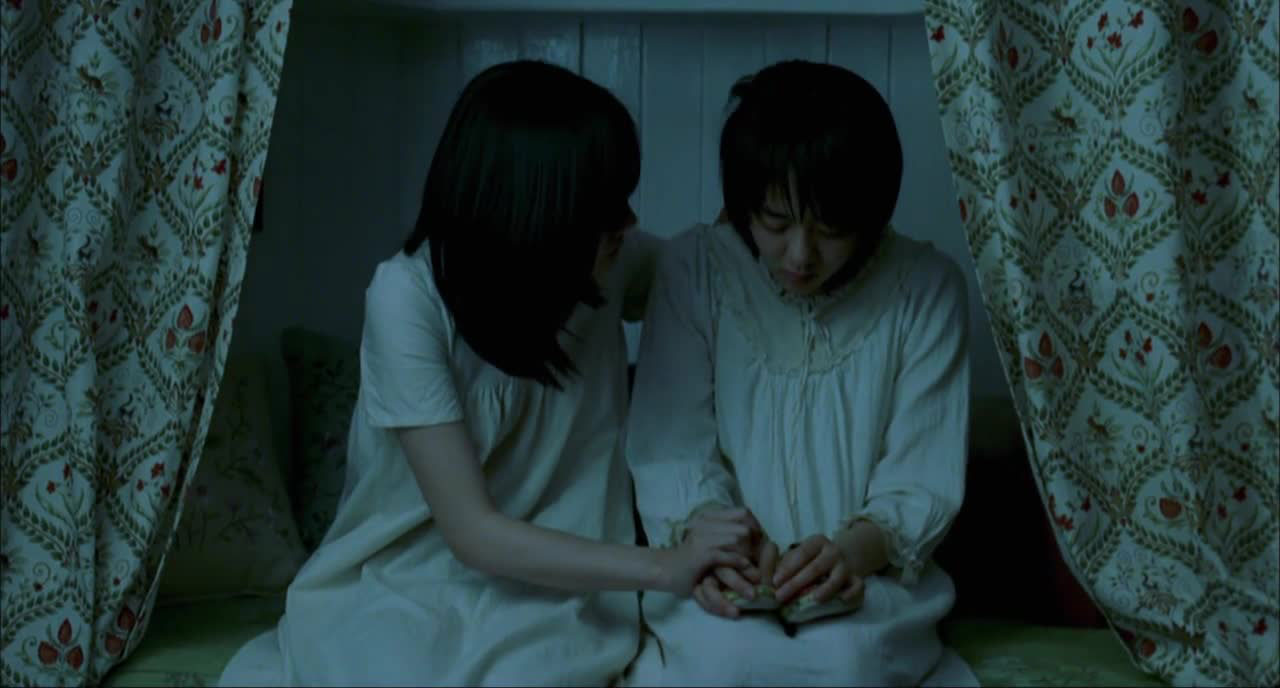
Director: Jee-woon Kim
Wrtier: Jee-woon Kim,
Stars: Lim Soo-jung Yum Jung-ah Kim Kap-su
Summary: After spending time in a mental hospital, a girl is reunited with her sister and returns home, only to see some truly strange events start to happen.
Among the most popular subgenres of the horror genre is psychological horror. There is always a new subject or horror to discuss in this cinema. It might be Antichrist by von Trier or It Follows by Robert Mitchell. This subgenre employs jump skiers, violent scenes, and stressful sequences to instill fear in the audience.
It is easy to see how the violent scenes in Antichrist differ from those in Wrong Turn. One is merely there to frighten, while the other is there to deliver a message. The audience typically remembers this subgenre more for the horror it inflicts on them. Loss, trust, mental disorders, etc. have been among the favorite topics of filmmakers of this genre. There are also themes of memories, family connections, and the mind in A Tale of Two Sisters 2003. One of the greatest movies in this subgenre was made by Kim Jee-woon, who was inspired by a Korean legend.

The psychological horror movie A Tale of Two Sisters was released in 2003 in South Korea. Kim Jee-woon is the movie’s writer and director. Among the actors in the film, we can mention Im Soo-jung, Yum Jung-ah, Kim Kap-soo, and Moon Geun-young. The movie has amassed South Korea’s all-time biggest box office total. It was the first Korean horror movie that was released in the United States, and it brought in $1,045,252 at the box office. let’s read a tale of two sisters explained. In the movie’s plot, a teenage girl named Su-mi returns home from a psychiatric clinic to her sister, father, and stepmother. After a while, frightening and paranormal things start to happen following her return and we will see a plot twist.
You need a beginning that piques the audience’s interest if you want to get their hearts beating. A Tale of Two Sisters starts off in this manner. In some ways, the movie’s opening scene serves as its synopsis. Su-mi remains silent, and the psychiatrist is the only one speaking. These two lines from the movie, “This is your family” and “I want you to remember that day completely,” compel us to watch on. With the help of relaxing music, a moving car, and the outside landscape, Kim Jee-woon introduces us to the adventure. Jee-woon prepares us for incredibly tense situations by instilling calmness, as he also did in “I Saw the Devil’s” opening. The opening scene of the movie is brutal. A proper start that tells us to be ready for a mysterious and scary journey.

The characters are now going to be introduced. Su-mi and Su-yeon appear to have a tight relationship at first glance. Su-mi plays the role of a worried sister to Su-yeon. Moo-hyeon, the father, likewise presents as a calm man. The arrival of the stepmother, Eun-joo, is noteworthy. Then, as the camera freezes, we catch a glimpse of a figure emerging from the shadows and speaking. After briefly switching to the first-person perspective, we once more see the stepmother’s domineering and self-centered behavior. The mood and cinematography of the movie do a good job of drawing us into its world before the next knots are revealed.
One after another, the knots in A Tale of Two Sisters are formed, and this becomes the movie’s weak point. The movie’s mood has changed to one that is nightmare-like. It all seems like a nightmare, from the father’s enigmatic comments to Su-yeon’s fear of her stepmother—a dream that has been depicted in a movie. The frightening sequences in the film are excellently done. There is no music or silence again. All the factors have come together to make us feel like we are in the cursed house and in Su-mi’s position.

If we claim that Jee-woon pushes us dangerously close to having a stroke, we are not lying. The woman with the twisted neck is the subject of the camera, and we are disturbed by a screeching noise. By the time this sequence is finished, we either have our eyes closed or are fully awake and experiencing this nightmare. Sequences that are both scary and bloody are prominently displayed. Soft music and pictures of nature are no longer present! From this point forward, we only have horror and sadness. We question whether what we see is reality or fiction due to the details, atmosphere, and actors’ movements.
Making distinctions between what is fictional and what is real can be difficult in movies when the issue of reality vs. fiction is complex. This complexity can occasionally go so horribly wrong that it frightens the spectator and is viewed as more of an insult to him. As an example, consider the film “Identity” by James Manglod; the complexity of these two movies is likewise similar. Both films have a silly and ambiguous beginning to pique our interest in seeing the rest of the movie. The biggest revelation in these two movies is that we have been watching someone’s imagination the entire time. The movie details and the knots must be quite numerous to achieve such a twist. So much so that the audience does not have a chance to think about them for a moment. If the movie allows the audience to get ahead of him, all the excitement of finding the knots will be lost.

By the third act of the film, the one where it is revealed that Su-yeon is dead and that it was only Su-mi’s hallucination, we have seen several stranger occurrences. The remaining knots must now be untangled by the movie. To whom was the father speaking? What explains the wardrobe’s mysterious nature? When one sister says, “I saw a dead girl in that house,” what does she mean? As long as we want to analyze the events, we see several other events. A violent, sadistic act that intensifies to the point that it becomes annoying. The use of violence in the movie is effective. Su-mi’s bad mood is supposed to be transferred to us; we are supposed to understand her and suffer with her. When she is dragged to the ground, it is as if we are being dragged to the ground. Or when the stepmother throws the statue on her, it is as if the statue fell on us.
One of the elements that distinguishes mystery movies and makes them unforgettable is the existence of an unexpected twist. When the viewer perceives the stepmother as the antagonist of the movie, we suddenly understand that she was not at home the entire time! We learn towards the end of the film that the main mother of the children hangs herself in the closet. Su-yeon tries to save her, but the closet also falls on her. The stepmother arrives and observes Su-yeon’s death but does not intervene to save her. This occurrence had a negative impact on the witnesses, and every one of them became involved in their own way.

This final twist was the final piece of the puzzle provided by the film. Then it says, “You have all the puzzle pieces!” Now it is your turn to solve the puzzle. Now it is clear that the crooked-neck woman in Su-mi’s dream is her mother. Su-mi’s concept of a stepmother is a self-satisfied individual who is responsible for her mother’s death and Su-yeon’s teasing. Su-mi was so traumatized by this incident that she developed multiple personality disorders and sometimes lived at Su-yeon’s place and sometimes at her stepmother’s place. The stepmother herself has not come to terms with the agony of this incident, and when she returns to that room, she hallucinates that a girl comes out from among the mattresses. Their older sister also has not digested the image of Su-yeon’s death, and sometimes she has a nervous attack because of that and sees her again.
As previously stated, the movie’s main flaw is that it becomes so engrossed in a mystery that it suffers from a lack of characterization. The characters are what we saw at the beginning of the movie. When the movie is over, we will only remember the shocks. We might conduct some research on it after the film, speak with someone who witnessed it, and write about it. However, after a long time, there may only be a shockingly bad movie to remember, nothing more, nothing less. Neither the stepmother nor Su-mi reach that level of hatred or identification that would remain in our memory.

In terms of filming, Lee Mo-gae has captured some stunning shots. He effectively conveys the horror of the picture by using first-person shots and close-ups. One of the film’s highlights is the music by Lee Byung-woo. His calm and frightening music effectively immerses the audience in the picture and produces a peculiar peace in him. The movie was edited well by Ko Im-Pyo and Lee Hyun-Mi. The movie’s pace is maintained throughout, and no extra scenes are included. The cuts are also sometimes quick, but not to the point that the spectator is bothered.
Kim Jee-woon has succeeded as a director in producing work that does not disappoint the viewers. He has pushed all of the components in the desired direction and developed work with a wholly melancholy and sick mood. Even though he overdoes the brutality and unpleasant scenes at times, he does so for the sake of the picture, so that the spectator can be left with this emotion for a long time. The actors’ acting is likewise of outstanding quality. Im Soo-jung best performance is as a concerned sister who despises her father and stepmother. Yum Yong-ah also portrays the role of an obnoxious stepmother with artistry. Kim Kap-soo and Moon Geun-young also play well in the roles of father and Su-yeon.

“A Tale of Two Sisters”, in general, concentrates on loss and coping with a catastrophe, and it effectively transmits its message to the viewer. It is regarded as a superb achievement from a technical standpoint. But the script’s minor problems keep it from being a great movie. The film should be seen multiple times. Its environment is detailed and mysterious, and by exploring more, you can learn new things. You could feel paranoid after seeing the movie. Perhaps you believe it is a nightmare and an illusion, and you have not yet awoken. The bizarre and melancholy hell that the movie depicts will stay with you for a long time, indicating that the movie was a success.
A Tale of Two Sisters ending explained:
Eun-joo receives a penalty for watching as Su-yeon died once she returns home. Even if Eun-joo did not personally commit the heinous act, she is definitely responsible for breaking this family apart. She has set off a fatal series of events by refusing to intervene to save Su-yeon out of spite.
Is A Tale of Two Sisters Based on a true story?
The 2003 South Korean psychological horror-drama film A Tale of Two Sisters was written and directed by Kim Jee-woon. The movie draws its inspiration from the Joseon Dynasty folktale Janghwa Hongryeon jeon, which has been filmed numerous times.
Is A Tale of Two Sisters Sad?
A Tale of Two Sisters is a horror film in general, but although being extremely unsettling, it also has a powerful portrayal of a family that has been harmed by betrayal and emotional anguish.





As I delved into the depths of Korean cinema, A Tale of Two Sisters emerged as a chilling masterpiece, weaving a tapestry of psychological horror and familial strife. I found myself captivated by its masterful blend of suspense, ambiguity, and emotional resonance, leaving me both deeply disturbed and profoundly intrigued.